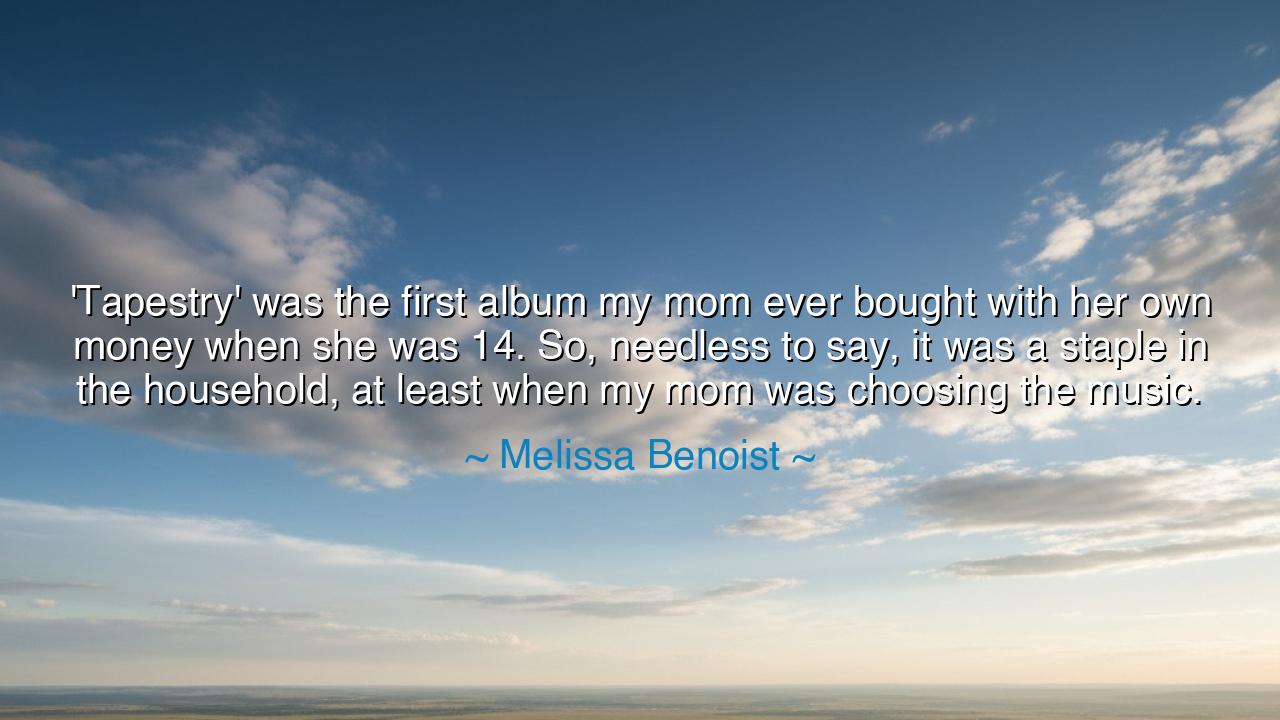
'Tapestry' was the first album my mom ever bought with her own
'Tapestry' was the first album my mom ever bought with her own money when she was 14. So, needless to say, it was a staple in the household, at least when my mom was choosing the music.






There are moments in life when music becomes more than sound—it becomes heritage, a thread that binds generations together. Melissa Benoist reflects on this when she says, “‘Tapestry’ was the first album my mom ever bought with her own money when she was 14. So, needless to say, it was a staple in the household, at least when my mom was choosing the music.” In these words, we see not only the value of music but its power to carry memory, identity, and influence across time. An album purchased in youth becomes a vessel, carrying the hopes, tastes, and spirit of one generation into the home of the next.
The story of Tapestry, Carole King’s iconic 1971 masterpiece, illustrates the universality of such influence. Its melodies and lyrics are imbued with honesty, introspection, and emotional resonance. For a young girl of 14 to invest her own earnings in this music is to make a declaration of personal taste, independence, and longing for beauty. Benoist’s reflection reminds us that the first encounters with art often leave the deepest marks—not just on the ears, but on the soul. Music becomes a living inheritance, passed silently from parent to child, shaping the atmosphere and the imagination of the household.
In many cultures, music has long served as a bridge between generations. The ancient Greeks sang of the exploits of heroes through lyric poetry; the bards of Ireland passed histories and myths through song; in African traditions, the drum and chant preserved lineage and morality. Benoist’s recollection is part of this timeless practice: a mother’s early choice of music becomes the landscape of her child’s upbringing. Even before conscious intention, the child absorbs the rhythms, stories, and emotional cadences of another’s life, weaving them into their own being.
The humor in Benoist’s words—that Tapestry was “a staple… at least when my mom was choosing the music”—belies a deeper truth about influence and autonomy. Children grow under the shadow of their parents’ preferences, yet they also learn to navigate, interpret, and eventually claim these influences as their own. Just as young Plato absorbed Socratic dialogue before finding his own philosophical voice, so too did Benoist absorb the musical world of her mother, laying the foundation for her own artistic sensibilities.
Music, like language, is a vessel for memory and emotion. To play Tapestry in the household was not simply to entertain; it was to live in the emotional world Carole King created: introspective, tender, and human. Such experiences shape empathy, creativity, and the aesthetic senses, teaching that art is not merely consumed, but internalized and carried forward. Benoist’s anecdote reminds us that what parents cherish becomes the soil in which the child’s own creativity grows.
Consider the story of Leonardo da Vinci, whose curiosity and inventiveness were nurtured by exposure to the works and interests of mentors and elders. Though separated by centuries and disciplines, the principle is the same: early encounters with passion, excellence, and expression—whether in art, music, or discourse—create a foundation for future genius. Benoist’s memory of her mother’s choices is a quiet testament to this ancient truth: that influence often arrives not as instruction, but as lived example.
From this, we may draw a profound lesson: cherish the art and values passed to you, and recognize their role in shaping your own path. Whether it is music, literature, philosophy, or tradition, these gifts are living threads connecting the past to the present. To absorb them attentively is to honor those who came before, and to prepare the ground for what will be passed on. Benoist’s reflection celebrates not only her mother’s choice, but the enduring power of artistic inheritance.
Thus, when next you hear a melody, recall that its significance may extend far beyond pleasure. It carries memory, history, and love. Let Tapestry, or any work of art, remind us that the smallest decisions—a first album purchased, a favorite poem recited—can resonate across generations, shaping hearts, minds, and souls. In the quiet act of listening, we participate in a lineage of emotion, creativity, and connection, sustaining the music of life itself.






AAdministratorAdministrator
Welcome, honored guests. Please leave a comment, we will respond soon